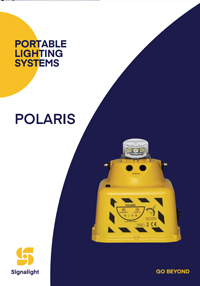The main (Map) view holds all the relevant information of the real-time overall airport / helipad portable runway lighting system and individual hardware status, as well as the controls to access and control the system, device groups, and individual hardware units.
The major parts of the user interface and controls are outlined and described below.
1. Main Application Navigation Bar
Allows navigation between the Main (Map) View of the application, and other secondary sections, like SETTINGS, HELP, ABOUT, and functionality like SIGN OUT; always visible, holds the application logo. Application always loads and starts in Main (MAP) View, navigating to other sections won’t close or stop the main view operation.
2. Application Status Bar
Displays critical summary information on the current system and hardware status (a), current system operation mode (b), and allow overall system control of the hardware (c) like switching On / Off, setting lighting level, enabling and disabling auto / scheduler functions. Clicking on the status bar will expand / collapse the Notification Area below.
3. System Notification Area
Scrollable and collapsible area that presents all current / actual system and hardware notifications, either informational, warning messages, or operational errors. Errors that have been reviewed can be manually dismissed / removed from the system here. The overall color of the status and notification areas is determined by the type of notifications present in the queue. Default / no issues is green, when only some warnings are present it is yellow, and when errors are present it is red.
4. Device Details Pane
The main area that presents the current status and details of an individual hardware device (a), as well as presenting operational status and allowing individual control (b), and presenting group operational status and allowing group control (c). This always presents information for the device currently selected on the Map View, and all the details and operational status are in real-time synchronization with the actual hardware status in the field. All the operational commands to the devices / groups are also sent from this view.
5. Application Map Area
This is the main view of the application, containing a Google Maps control, on which all the hardware devices (a) are placed according to their real-time reported location from their GPS sensors. The currently selected device has an additional Info Popup open (b), presenting all its reported field data, besides being shown in the Details Pane. All the hardware devices registered with the system are initially visible on the map, all usual maps operations like zooming, panning, etc. plus additional device groups filtering, device error highlighting, etc. are available and described below.
Download presentation of Airport Portable lights systems:

Airport Portable lights systems
